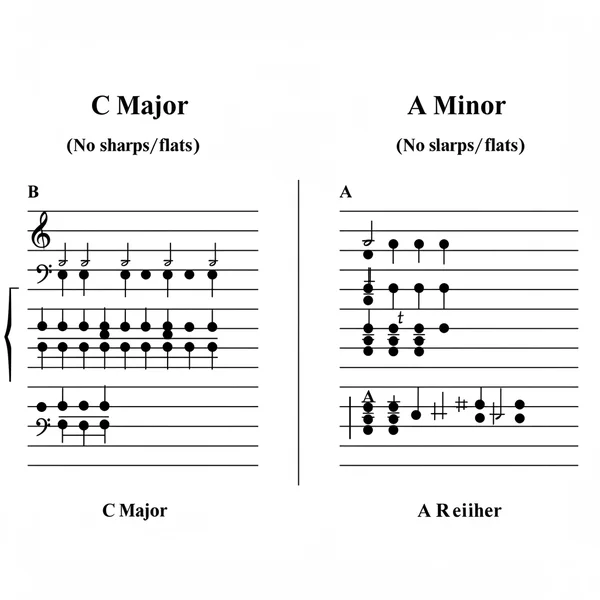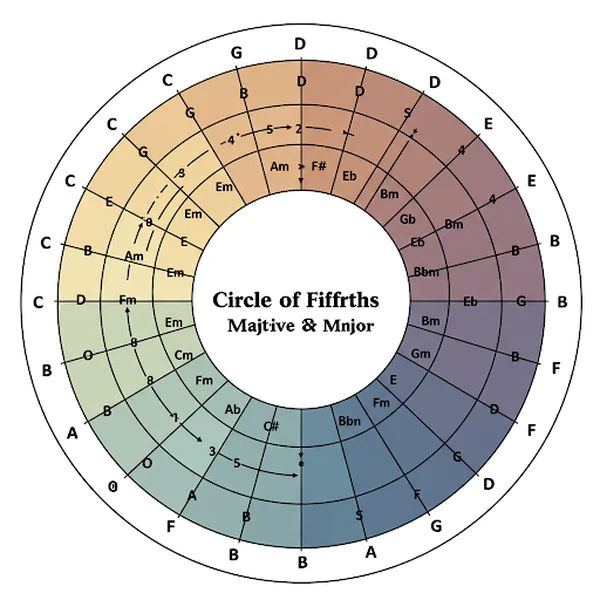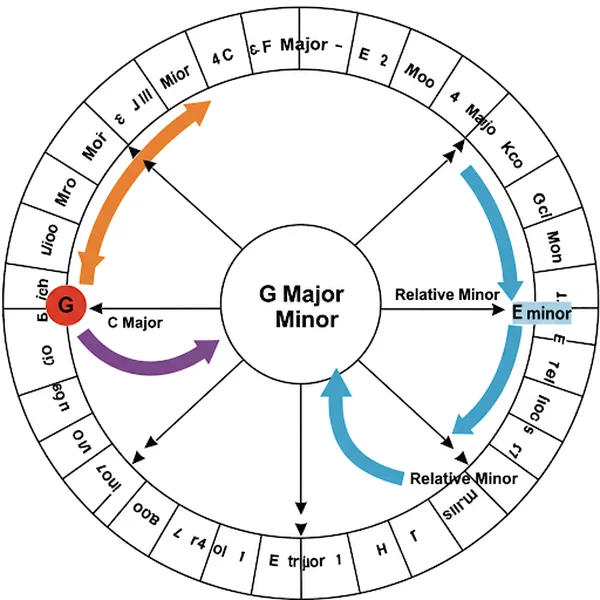ค้นหาคีย์ไมเนอร์สัมพัทธ์บนวงกลมวงควินท์
ความเข้าใจความสัมพันธ์ระหว่างคีย์เมเจอร์และไมเนอร์เป็นพื้นฐานในทฤษฎีดนตรี เปิดประตูสู่ความเข้าใจที่ลึกซึ้งยิ่งขึ้นเกี่ยวกับฮาร์โมนี เมโลดี้ และการประพันธ์ แต่คุณจะหาคู่ "เงา" ของคีย์เมเจอร์ได้อย่างไร คีย์ที่ใช้ลายเซ็นเดียวกันแต่ให้ความรู้สึกที่แตกต่างกัน คำตอบอยู่ในเครื่องมือภาพที่ทรงพลัง: วงกลมวงควินท์ การเรียนรู้ความสัมพันธ์ระหว่างเมเจอร์และไมเนอร์จะง่ายขึ้นมากเมื่อคุณเห็นมันเรียงรายอย่างชัดเจน สำรวจเครื่องมือวงกลมวงควินท์แบบใช้งานง่าย บนเว็บไซต์ของเราและค้นพบการเชื่อมต่อเหล่านี้ด้วยตัวคุณเอง!
คีย์เมเจอร์และไมเนอร์สัมพัทธ์คืออะไร
แล้วอะไรกันแน่ที่กำหนดการเชื่อมต่อนี้ ที่แก่นแท้แล้ว คีย์เมเจอร์และไมเนอร์สัมพัทธ์มีความเชื่อมโยงกันอย่างแท้จริง
การเชื่อมต่อลายเซ็นคีย์ที่ใช้ร่วมกัน
ลักษณะเฉพาะของคีย์สัมพัทธ์คือใช้ลายเซ็นคีย์เดียวกันอย่างแน่นอน – ชุดของชาร์ปหรือแฟลตที่ใช้กับดนตรี ตัวอย่างเช่น C เมเจอร์ไม่มีชาร์ปหรือแฟลต และ A ไมเนอร์ซึ่งเป็นคีย์ไมเนอร์สัมพัทธ์ก็เช่นกัน พื้นฐานที่ใช้ร่วมกันนี้มีความสำคัญ แต่แตกต่างจากคีย์คู่ขนาน (เช่น C เมเจอร์และ C ไมเนอร์) ซึ่งใช้โทนิกเดียวกันแต่มีลายเซ็นคีย์ที่แตกต่างกัน
ความเข้าใจโน้ตโทนิกและโทนเสียง
แม้ว่าพวกมันจะใช้ลายเซ็นคีย์เดียวกัน แต่คีย์สัมพัทธ์ถูกสร้างขึ้นบนโน้ตเริ่มต้นที่แตกต่างกัน เรียกว่าโน้ตโทนิก C เมเจอร์อยู่รอบๆ C ในขณะที่ A ไมเนอร์อยู่รอบๆ A ความแตกต่างในโทนิกนี้เป็นสิ่งที่สร้างเอกลักษณ์และสร้างความรู้สึกทางดนตรีหรือโทนเสียงที่แตกต่างกัน แม้ว่าจะใช้โน้ตหลักชุดเดียวกันก็ตาม
เมเจอร์กับไมเนอร์: ความแตกต่างของเสียงและอารมณ์
โดยทั่วไป คีย์เมเจอร์ถูกมองว่าสว่างกว่า มีความสุขกว่า หรือมีความมั่นคงมากกว่า ในขณะที่คีย์ไมเนอร์มักกระตุ้นความรู้สึกเศร้า โศกเสียใจ หรือตึงเครียด การทำความเข้าใจไมเนอร์สัมพัทธ์ช่วยให้ผู้เล่นดนตรีสามารถแตะเข้าถึงจานสีอารมณ์ที่ตัดกันนี้ได้ในขณะที่ทำงานภายในกรอบฮาร์โมนิกเดียวกัน แต่พวกมันเชื่อมโยงกันทางสายตาอย่างไร

เหตุใดความเข้าใจความสัมพันธ์ระหว่างเมเจอร์และไมเนอร์จึงสำคัญ
การเข้าใจความสัมพันธ์ระหว่างเมเจอร์และไมเนอร์ไม่ใช่แค่ทางวิชาการเท่านั้น แต่ยังมีประโยชน์ที่จับต้องได้สำหรับนักดนตรีทุกระดับ เหตุใดคุณจึงควรลงทุนเวลาในการทำความเข้าใจแนวคิดนี้
การทำให้แนวคิดทฤษฎีดนตรีง่ายขึ้น
การรู้ไมเนอร์สัมพัทธ์จะบอกลายเซ็นคีย์สำหรับคีย์ไมเนอร์นั้นได้ทันทีโดยไม่ต้องท่องจำเพิ่มเติม ถ้าคุณรู้ว่า G เมเจอร์มีชาร์ปหนึ่งตัว (F#) คุณจะรู้โดยอัตโนมัติว่า E ไมเนอร์ซึ่งเป็นคีย์สัมพัทธ์ก็มีชาร์ปหนึ่งตัวเช่นกัน สิ่งนี้ทำให้การเรียนรู้ลายเซ็นคีย์และการทำความเข้าใจรูปแบบสเกลทั่ววงกลมวงควินท์ง่ายขึ้นอย่างมาก
การเพิ่มประสิทธิภาพเทคนิคการประพันธ์เพลงและการเปลี่ยนแปลง
นักประพันธ์และนักประดิษฐ์มักใช้ความสัมพันธ์ระหว่างคีย์สัมพัทธ์ การเคลื่อนที่ระหว่างคีย์เมเจอร์และไมเนอร์สัมพัทธ์ (หรือในทางกลับกัน) เป็นวิธีการทั่วไปและมีประสิทธิภาพในการสร้างการเปลี่ยนแปลงทางอารมณ์และเพิ่มความน่าสนใจให้กับดนตรี – เทคนิคสำคัญในการประพันธ์เพลงและการเปลี่ยนแปลง คุณสามารถสำรวจการเปลี่ยนแปลงเหล่านี้ได้อย่างง่ายดายโดยใช้ วงกลมวงควินท์แบบโต้ตอบ ของเรา
การจดจำความสัมพันธ์คอร์ดได้ง่ายขึ้น
คีย์สัมพัทธ์ใช้คอร์ดเดียวกันหลายๆ คอร์ด การทำความเข้าใจการเชื่อมต่อนี้ช่วยให้คุณวิเคราะห์ความคืบหน้าของคอร์ด ทำนายการเคลื่อนไหวฮาร์โมนิก และตัดสินใจได้อย่างรอบรู้มากขึ้นเมื่อเล่นแบบอิมโพรไวส์หรือเรียบเรียง ความสัมพันธ์ของคอร์ดที่ใช้ร่วมกันเหล่านี้จะชัดเจนยิ่งขึ้นเมื่อมองเห็นภาพ พร้อมที่จะปลดล็อกประโยชน์เหล่านี้ด้วยคู่มือภาพหรือไม่
การมองเห็นคีย์ไมเนอร์สัมพัทธ์บนวงกลมวงควินท์
วงกลมวงควินท์เป็นเครื่องมือที่สมบูรณ์แบบสำหรับการมองเห็นคีย์และความสัมพันธ์ของพวกมัน รวมถึงการเชื่อมต่อเมเจอร์-ไมเนอร์ที่สำคัญ มันทำงานอย่างไร
การค้นหาคีย์เมเจอร์บนวงแหวนด้านนอก
โดยทั่วไป วงกลมวงควินท์จะแสดงคีย์เมเจอร์ที่เรียงกันตามเข็มนาฬิกาในช่วงเวลาของควินท์ที่สมบูรณ์รอบวงแหวนด้านนอก C เมเจอร์อยู่ด้านบน G เมเจอร์อยู่ห่างไปหนึ่งขั้นตามเข็มนาฬิกา D เมเจอร์ถัดไป และอื่นๆ
การระบุคีย์ไมเนอร์ที่สอดคล้องกันบนวงแหวนด้านใน
บ่อยครั้ง ภายในคีย์เมเจอร์แต่ละคีย์บนวงแหวนด้านนอก คุณจะพบคีย์ไมเนอร์สัมพัทธ์ที่แสดงอยู่บนวงแหวนด้านใน ดังนั้น ภายใน C เมเจอร์ คุณจะเห็น A ไมเนอร์ ภายใน G เมเจอร์ คุณจะพบ E ไมเนอร์ การจัดวางนี้ทำให้การมองเห็นคีย์ไมเนอร์ของวงกลมวงควินท์เป็นเรื่องที่เข้าใจง่ายอย่างไม่น่าเชื่อ

วิธีที่เครื่องมือแบบโต้ตอบของเราแสดงความสัมพันธ์ระหว่างเมเจอร์และไมเนอร์
ความสวยงามของ วงกลมวงควินท์แบบโต้ตอบ คือมันจะเน้นความสัมพันธ์เหล่านี้แบบไดนามิก เมื่อคุณเลือกคีย์เมเจอร์ ไมเนอร์สัมพัทธ์มักจะแสดงอย่างชัดเจน ทำให้การเชื่อมต่อปรากฏขึ้นทันที คุณใช้วงกลมเพื่อหาคีย์เหล่านั้นด้วยตนเองได้อย่างไร
ขั้นตอนง่ายๆ ในการค้นหาไมเนอร์สัมพัทธ์โดยใช้วงกลม
แม้จะไม่มีวงแหวนด้านในแสดงอย่างชัดเจน การค้นหาไมเนอร์สัมพัทธ์โดยใช้โครงสร้างวงกลมวงควินท์มาตรฐานนั้นตรงไปตรงมา ต่อไปนี้คือวิธีที่คุณสามารถค้นหาคีย์ไมเนอร์สัมพัทธ์ได้อย่างรวดเร็ว
ระบุคีย์เมเจอร์ของคุณบนวงกลม
ขั้นแรก ให้ระบุคีย์เมเจอร์ที่คุณต้องการค้นหาไมเนอร์สัมพัทธ์บนวงกลมด้านนอก สมมติว่าเราใช้ G เมเจอร์เป็นตัวอย่าง
กฎ "สามขั้นตอนลง" (หรือการเลื่อนตามเข็มนาฬิกา)
จากตำแหน่งของคีย์เมเจอร์ของคุณ ให้เลื่อนสามขั้นตอนทวนเข็มนาฬิกาไปรอบๆ วงกลม จาก G เมเจอร์ การเลื่อนสามขั้นตอนทวนเข็มนาฬิกาจะนำคุณไปที่ E ดังนั้น E ไมเนอร์จึงเป็นไมเนอร์สัมพัทธ์ของ G เมเจอร์ (หรือคิดว่าโทนิกของคีย์ไมเนอร์อยู่ต่ำกว่าโทนิกของคีย์เมเจอร์หนึ่งในสามของเสียงเล็กน้อย – G ลงไปที่ E คือหนึ่งในสามของเสียงเล็กน้อย)
การยืนยันคีย์ไมเนอร์และลายเซ็นของมัน
ตรวจสอบผลลัพธ์ของคุณ G เมเจอร์มีชาร์ปหนึ่งตัว (F#) E ไมเนอร์ใช้ลายเซ็นคีย์ F# เช่นกัน วิธีการนี้ใช้ได้ผล! กระบวนการง่ายๆ นี้ใช้ได้กับคีย์เมเจอร์ใดๆ บนวงกลม วิธีนี้ใช้ได้กับทุกคีย์หรือไม่ มาดูกัน

การค้นหาไมเนอร์สัมพัทธ์สำหรับคีย์ทั่วไป
มาเสริมสร้างวิธีการนี้ด้วยตัวอย่างเพิ่มเติมอีกสองสามตัวอย่าง การมองเห็นมันจะทำให้แนวคิดนี้ติดแน่น
C เมเจอร์และ A ไมเนอร์สัมพัทธ์
เริ่มต้นที่ C เมเจอร์ (ด้านบนสุดของวงกลม) เลื่อนสามขั้นตอนทวนเข็มนาฬิกา: C -> F -> Bb -> A ไมเนอร์สัมพัทธ์คือ A ไมเนอร์ ทั้งคู่ไม่มีชาร์ปหรือแฟลต
G เมเจอร์และ E ไมเนอร์สัมพัทธ์
เริ่มต้นที่ G เมเจอร์ (หนึ่งขั้นตามเข็มนาฬิกาจาก C) เลื่อนสามขั้นตอนทวนเข็มนาฬิกา: G -> C -> F -> E ไมเนอร์สัมพัทธ์คือ E ไมเนอร์ ทั้งคู่มีชาร์ปหนึ่งตัว (F#)
Eb เมเจอร์และ C ไมเนอร์สัมพัทธ์
เริ่มต้นที่ Eb เมเจอร์ (สามแฟลต) เลื่อนสามขั้นตอนทวนเข็มนาฬิกา: Eb -> Ab -> Db -> C ไมเนอร์สัมพัทธ์คือ C ไมเนอร์ ทั้งคู่มีสามแฟลต (Bb, Eb, Ab)
ฝึกฝนกับวงกลมวงควินท์แบบโต้ตอบ
การอ่านเกี่ยวกับมันเป็นเรื่องหนึ่ง แต่การทำมันจะทำให้ความเข้าใจแข็งแกร่งขึ้น อย่าแค่เพียงอ่าน – ลองทำดู! ฝึกฝนการค้นหาคีย์ไมเนอร์สัมพัทธ์ ตอนนี้ด้วยเครื่องมือฟรีของเรา มันเป็นวิธีที่ดีที่สุดในการทำความเข้าใจความสัมพันธ์เหล่านี้
เชี่ยวชาญไมเนอร์สัมพัทธ์ด้วยเครื่องมือวงกลมวงควินท์
ความเข้าใจความสัมพันธ์ระหว่างเมเจอร์และไมเนอร์เป็นหัวใจสำคัญของทฤษฎีดนตรี และวงกลมวงควินท์ให้แผนที่ที่ใช้งานง่ายที่สุดในการนำทาง ด้วยการรู้วิธีค้นหาไมเนอร์สัมพัทธ์สำหรับคีย์เมเจอร์ใดๆ คุณจะทำให้การจำลายเซ็นคีย์ง่ายขึ้น ปลดล็อกความเป็นไปได้ในการประพันธ์เพลง และเพิ่มความเข้าใจฮาร์โมนิกของคุณกุญแจสำคัญคือการมองเห็นภาพและการฝึกฝน
พร้อมที่จะเพิ่มความเข้าใจทฤษฎีดนตรีและวงกลมวงควินท์ของคุณหรือไม่ เยี่ยมชม circleoffifths.io วันนี้ และสำรวจการเชื่อมต่อ!
คีย์ไมเนอร์สัมพัทธ์ & วงกลมวงควินท์: คำถามที่พบบ่อย
ต่อไปนี้เป็นคำตอบสำหรับคำถามทั่วไปเกี่ยวกับคีย์สัมพัทธ์และวงกลมวงควินท์:
ฉันจะหาเมเจอร์สัมพัทธ์ของคีย์ไมเนอร์บนวงกลมได้อย่างไร
มันเป็นกระบวนการย้อนกลับ! เริ่มต้นที่คีย์ไมเนอร์ของคุณ (โดยปกติจะอยู่บนวงกลมด้านในหรือพบโดยใช้วิธีการข้างต้น) เลื่อนสามขั้นตอนตามเข็มนาฬิกาไปรอบๆ วงกลม (หรือคิดถึงหนึ่งในสามของเสียงเล็กน้อย) ตัวอย่างเช่น จาก A ไมเนอร์ การเลื่อนขึ้นหนึ่งในสามของเสียงเล็กน้อย (สามครึ่งขั้น) จะนำคุณไปที่ C ดังนั้น C เมเจอร์จึงเป็นเมเจอร์สัมพัทธ์ บนวงกลม ถ้า A ไมเนอร์อยู่ภายใน C เมเจอร์ การหาเมเจอร์สัมพัทธ์หมายถึงการมองออกไปจากตำแหน่งของคีย์ไมเนอร์
คีย์สัมพัทธ์ใช้โน้ตเดียวกันอย่างแน่นอนหรือไม่
ไม่ อย่างแน่นอน แม้ว่าพวกมันจะใช้ลายเซ็นคีย์เดียวกัน แต่สเกลที่แท้จริงจะแตกต่างกันเพราะพวกมันเริ่มต้นที่โน้ตโทนิกที่แตกต่างกัน สเกล C เมเจอร์ใช้ C-D-E-F-G-A-B-C สเกล A ไมเนอร์ธรรมชาติ (คีย์สัมพัทธ์) ใช้ A-B-C-D-E-F-G-A โน้ตเดียวกัน ลำดับและความสำคัญที่แตกต่างกัน ส่งผลให้โทนเสียงต่างกัน สเกลไมเนอร์ฮาร์โมนิกและเมโลดิกจะแนะนำการเปลี่ยนแปลงเพิ่มเติมที่โดยปกติจะไม่แสดงบนวงกลมพื้นฐาน
ไมเนอร์สัมพัทธ์อยู่ต่ำกว่าเมเจอร์สามครึ่งขั้นเสมอหรือไม่
ใช่ ช่วงเวลาที่อยู่ระหว่างโทนิกของคีย์เมเจอร์และโทนิกของไมเนอร์สัมพัทธ์นั้นอยู่ต่ำกว่าหนึ่งในสามของเสียงเล็กน้อยเสมอ (ซึ่งเท่ากับสามครึ่งขั้น) ช่วงเวลานี้สอดคล้องกันในทุกคีย์
เครื่องมือ circleoffifths.io สามารถแสดงคีย์สัมพัทธ์โดยอัตโนมัติได้หรือไม่
แน่นอน! เครื่องมือแบบโต้ตอบ ของเราถูกออกแบบมาเพื่อสิ่งนี้ การเลือกคีย์มักจะเน้นคู่สัมพัทธ์ ทำให้การมองเห็นไมเนอร์สัมพัทธ์ง่ายดายและไม่ต้องเดา
อะไรคือความแตกต่างระหว่างไมเนอร์สัมพัทธ์และไมเนอร์คู่ขนาน
นี่เป็นจุดที่ทำให้เกิดความสับสน คีย์ไมเนอร์สัมพัทธ์ใช้ลายเซ็นคีย์เดียวกันแต่มีโทนิกที่แตกต่างกัน (เช่น C เมเจอร์และ A ไมเนอร์) คีย์ไมเนอร์คู่ขนานใช้โทนิกเดียวกันแต่มีลายเซ็นคีย์ที่แตกต่างกัน (เช่น C เมเจอร์และ C ไมเนอร์) C ไมเนอร์มีสามแฟลต (Bb, Eb, Ab) ในขณะที่ C เมเจอร์ไม่มี พวกมันให้เสียงที่แตกต่างกันมากแม้ว่าจะเริ่มต้นที่โน้ตเดียวกันก็ตาม